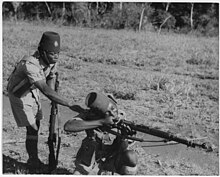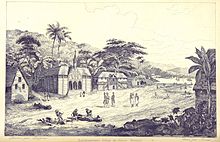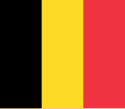Belgian colonial empire
Belgian colonial empire | |
|---|---|
| 1908–1962 | |
 Map of Belgium's colonies at their maximum extent in the interwar period. | |
| Capital | Brussels |
| Common languages | Frenchserved as the main colonial language, butDutchwas also used to a lesser extent Local:
various |
| Religion | Roman Catholicism (Official)[1] |
| Government | Constitutional monarchy |
| King | |
• 1908-1909 | Leopold II(first) |
• 1951–1962 | Baudouin(last) |
| History | |
| 1908 | |
• Annexation ofRuanda-Urundi | 1916 |
• Independence ofCongo | 1960 |
| 1 July 1962 | |
| Area | |
• Total | 2,430,270 km2(938,330 sq mi) |
| Currency | Belgian franc,Congolese francandRuanda-Urundi franc |
Belgiumcontrolled several territories and concessions during the colonial era, principally theBelgian Congo(modernDR Congo) from 1908 to 1960,Ruanda-Urundi(modernRwandaandBurundi) from 1922 to 1962, andLado Enclave(modernCentral Equatoriaprovince inSouth Sudan) from 1884 to 1910. It also had small concessionsin Guatemala(1843–1854) andBelgian concession of Tianjinin China (1902–1931) and was a co-administrator of theTangier International ZoneinMorocco.
Roughly 98% of Belgium's overseas territory was just one colony (about 76 times larger than Belgium itself) – known as the Belgian Congo. The colony was founded in 1908 following the transfer of sovereignty from theCongo Free State,which was the personal property of Belgium's king,Leopold II.The violence used by Free State officials against indigenous Congolese and the ruthless system of economic extraction had led to intense diplomatic pressure on Belgium to take official control of the country. Belgian rule in the Congo was based on the "colonial trinity" (trinité coloniale) of state, missionary and private company interests. During the 1940s and 1950s, the Congo experienced extensive urbanization and the administration aimed to make it into a "model colony". As the result of a widespread and increasingly radical pro-independence movement, the Congo achieved independence, as theRepublic of Congo-Léopoldvillein 1960.
Of Belgium's other colonies, the most significant wasRuanda-Urundi,a portion ofGerman East Africa,which was given to Belgium as aLeague of Nations Mandate,whenGermanylost all of itscoloniesat the end ofWorld War I.Following theRwandan Revolution,the mandate became the independent states ofBurundiandRwandain 1962.[2]
Background in the early 19th century
[edit]Belgium,aconstitutional monarchy,gained itsindependencein 1830 from theUnited Kingdom of the Netherlands.By the time this was universally recognized in 1839, most European powers already hadcoloniesandprotectoratesoutside Europe and had begun to formspheres of influence.
During the 1840s and 50s,King Leopold Itentatively supported several proposals to acquire territories overseas. In 1843, he signed a contract withLadd & Co.to colonize theKingdom of Hawaii,but the deal fell apart when Ladd & Co. ran into financial difficulties.[3]Belgian traders also extended their influence inWest Africabut this too fell apart following theRio Nuñez Incidentof 1849 and growing Anglo-French rivalry in the region.
By the time Belgium's second king,Leopold II,was crowned, Belgian enthusiasm forcolonialismhad abated. Successive governments viewed colonial expansion as economically and politically risky and fundamentally unrewarding, and believed thatinformal empire,continuing Belgium's booming industrial trade in South America and Russia, was much more promising. As a result, Leopold pursued his colonial ambitions without the support of theBelgian government.The archives of theBelgian Ministry of Foreign Affairs and Tradeshow that Leopold investigated possible colonies in dozens of territories.[4]
The Congo
[edit]Congo Free State (1885–1908)
[edit]
Colonization of the Congobegan in the late 19th century.King Leopold IIof Belgium, frustrated by his nation's lack of international power and prestige, tried to persuade the Belgian government to support colonial expansion around the then-largely unexploredCongo Basin.Their refusal led Leopold to create a state under his own personal rule. With support from a number of Western countries who saw Leopold as a usefulbufferbetween rival colonial powers, Leopold achieved international recognition for theCongo Free Statein 1885.[5]
The Free State government exploited the Congo for its natural resources, firstivoryand later rubber which was becoming a valuable commodity. With the support of the Free State's military, theForce Publique,the territory was divided into private concessions. TheAnglo-Belgian India Rubber Company(ABIR), among others, used force and brutality to extract profit from the territory. Their regime in the Congo used forced labour, and murder and mutilation on indigenous Congolese who did not fulfill quotas for rubber collections. Millions of Congolese died during this time.[6]Many deaths can be attributed to new diseases introduced by contact with European colonists, includingsmallpoxwhich killed nearly half the population in the areas surrounding the lowerCongo River.[7]

A sharp reduction of the population of the Congo throughexcess deathsoccurred in the Free State period but estimates of the deaths toll vary considerably. Although the figures are estimates, it is believed that as many as ten million Congolese died during the period,[8][9][10][11]roughly a fifth of the population. As the first census did not take place until 1924, it is difficult to quantify the population loss of the period and these figures have been disputed by some who, likeWilliam Rubinstein,claim that the figures cited byAdam Hochschildare speculative estimates based on little evidence.[12]
Although the Congo Free State was not a Belgian colony, Belgium was its chief beneficiary in terms of trade and the employment of its citizens. Leopold II personally accumulated considerable wealth from exports of rubber and ivory acquired at gunpoint. Much of this was spent on public buildings inBrussels,OstendandAntwerp.[citation needed]
Lado Enclave (1884–1910)
[edit]The Lado Enclave was a Belgian Colony that existed from 1894 until 1910, situated on the west bank of the Upper Nile in what is now Central Equatoria province in South Sudan and northwest Uganda. Its capital was the town of Lado.
British desire for aCape to Cairo railwayled them to negotiate with the Belgians to exchange the area that became the Lado Enclave for a narrow strip of territory in eastern Congo between LakesAlbertandTanganyika.These negotiations resulted in the 1894 British-Congolese Treaty, signed on 12 May, under which the British leased all of the Nile basin south of the 10° north latitude toKing Leopold II of the Belgiansfor the period of his lifetime.[13][14]This area, called the Lado Enclave, linked the Congo with the navigable Nile.[15]The Lado Enclave was important to the Belgian Congo as it includedRejaf,which was the terminus for boats on theNile,as the rapids there proved a barrier to further travel.[16]Rejaf was the seat of the commander, the only European colonial official within the enclave, who were in place from 1897 to June 1910. Efforts were made to properly defend Lado against any possible incursion by another colonial power, with twelve heavyKruppfort guns installed in November 1906.[17]
However, there continued to be uncertainty in the enclave with the knowledge that the enclave would revert to British rule upon Leopold's death. As a result, the Belgians were unable to create an effective government, leading to civil unrest within the enclave.[18]At the death of King Leopold, the Belgians handed over Lado to the British in 1910.
Belgian Congo (1908–1960)
[edit]
Leopold achieved international recognition for the Congo Free State in 1885.[5]By the turn of the century, however, the violence used by Free State officials against indigenous Congolese and the ruthless system of economic extraction led to intense diplomatic pressure on Belgium to take official control of the country, which it did in 1908, creating the Belgian Congo.[19]
Belgian rule in the Congo was based on the "colonial trinity" (trinité coloniale) ofstate,missionaryandprivate companyinterests.[20]The privileging of Belgian commercial interests meant that large amounts of capital flowed into the Congo and that individual regions becamespecialised.On many occasions, the interests of the government and private enterprise became closely tied, and the state helped companies break strikes and remove other barriers raised by the indigenous population.[20]The country was split into nesting, hierarchically organised administrative subdivisions, and run uniformly according to a set "native policy" (politique indigène). This was in contrast to the British and the French, who generally favoured the system ofindirect rulewhereby traditional leaders were retained in positions of authority under colonial oversight. DuringWorld War I,Congolese troops participated in offensives against German forces in the area of modern-dayRwandaandBurundiwhich were placed under Belgian occupation. The Congo had a high degree ofracial segregation.The large numbers of white immigrants who moved to the Congo after the end ofWorld War IIcame from across the social spectrum, but were always treated as superior to black citizens.[21]

Congolese troopsparticipated in World War IIand were instrumentalin forcing the Italians out of their East African coloniesduring theEast African Campaign.During the 1940s and 1950s, the Congo had extensiveurbanization,and the colonial administration began variousdevelopmentprogrammes aimed at making the territory into a "model colony".[22]One of the results was the development of a new middle class of Europeanised African "évolués"in the cities.[22]By the 1950s the Congo had awage labourforce twice as large as that in any other African colony.[23]
In 1960, as the result of a widespread and increasingly radicalpro-independence movement,the Congo achieved independence, becoming theRepublic of Congo-LéopoldvilleunderPatrice LumumbaandJoseph Kasa-Vubu.Poor relations between factions within the Congo, the continued involvement of Belgium in Congolese affairs, and intervention by major parties of theCold Warled to a five-year-long period of war and political instability, known as theCongo Crisis,from 1960 to 1965. This ended with the seizure of power byJoseph-Désiré Mobutu.
Ruanda-Urundi
[edit]
Ruanda-Urundi was a part ofGerman East Africaunder Belgianmilitary occupationfrom 1916 to 1924 in the aftermath ofWorld War I,whena military expeditionhad removed the Germans from the colony. It became aLeague of Nations Class B mandateallotted to Belgium, from 1924 to 1945. It was designated as aUnited Nations trust territory,still under Belgian administration, until 1962, when it developed into the independent states ofRwandaandBurundi.After Belgium began administering the colony, it generally maintained the policies established by the Germans, including indirect rule via localTutsirulers, and a policy of ethnic identity cards (later retained in the Republic of Rwanda). Revolts and violence against Tutsi, known as theRwandan Revolution,occurred in the events leading toindependence.
Minor possessions
[edit]Santo Tomás, Guatemala (1843–1854)
[edit]

In 1842, a ship sent by KingLeopold I of Belgiumarrived in Guatemala; the Belgians observed the natural riches of the department ofIzabaland decided to settle inSanto Tomas de Castillaand buildinfrastructurein the region.Rafael Carreragave them the region in exchange for sixteen thousand pesos every year from the government of Guatemala. On 4 May 1843, theGuatemalanparliament issued a decree giving the district ofSanto Tomás"in perpetuity" to theCompagnie belge de colonisation,a private Belgian company under the protection of KingLeopold I of Belgium.It replaced the failed BritishEastern Coast of Central America Commercial and Agricultural Company.[24]Belgian colonizing efforts in Guatemala ceased in 1854, due to lack of financing and highmortalitydue toyellow feverandmalaria,endemicdiseases of the tropical climate.[25]
Status
[edit]While theCompagnie belge de colonisationwas granted the land in perpetuity, the concession did not become a colony in the political sense. Article 4 of the May 1842Acte de concessionclearly stated that the cession of the territory to the Belgian company did not involve, implicitly or explicitly, a cession of sovereignty over the territory, which would forever remain under the sovereignty and jurisdiction of Guatemala. Article 5 stated that upon their arrival on the territory, the settlers would become Guatemalan natives (indigènes de Guatemala) fully subject to the existing constitution and laws of the country, relinquishing their former Belgian or other national birthright, as well as any claim to any privileges or immunity as foreigners. Justice was to be administered by judges named by the government (art. 40). No foreign troops were to be allowed on the concession and Guatemalan troops were to garrison two forts that were to be built near the projected new town. (art. 18–22)[26]
Tianjin Concession (1900–1931)
[edit]The city ofTianjin(Tientsin), atreaty portinChina(1860–1945) includednine foreign-controlled concessions(Chinese:Tô Giới;pinyin:zūjiè). In the years following theBoxer Rebellion,the diplomatMaurice Joostensnegotiated aconcessionfor Belgium. The Belgian concession was proclaimed on 7 November 1900 and spanned some 100 hectares (250 acres).[27]Although Belgian companies invested in Tianjin, especially in the city'stramsystem, the Belgian concession remained inactive. An agreement was reached between the Belgian and Chinese governments in August 1929 to return the concession to China.[28]The agreement was approved by the Belgian parliament on 13 July 1931.
In the late 19th century, Belgian engineers were employed on construction of theBeijing–Hankou Railway,leading the Belgian government to unsuccessfully claim a concession inHankou(Hankow). The Belgian claim was never formally recognised and the proposal was dropped in 1908.[29]
Tangier International Zone (1925–1956)
[edit]In 1880 and 1905, Belgium was a signatory to theMadrid Conventionand theAlgeciras Conferenceon Morocco. Thus, from 1925 to 1940 and from 1945 to 1956, Belgium was one of the nine nations that administered theTangier International Zone.The last two administrators (1954-1956) were Belgian, Belgium was also subordinate to the customs and financial administration and the gendarmerie in Tangier.
Isola Comacina (1919)
[edit]In 1919, the island ofComacinawas bequeathed to KingAlbert I of Belgiumfor a year, and became an enclave under the sovereignty of Belgium. After a year, it was returned to the Italian State in 1920. The Consul of Belgium and the president of theBrera Academyestablished a charitable foundation with the goal of building a village for artists and a hotel.[30]
See also
[edit]- History of Belgium
- Atrocities in the Congo Free State
- Foreign relations of Belgium
- Rio Nuñez incident
- Société Belge d'Études Coloniales(est. 1894)
- Colonial University of Belgium(est. 1920 in Antwerp)
- Institut Royal Colonial Belge(est. 1928)
- Belgium–Mexico relations
Notes and references
[edit]Footnotes
[edit]References
[edit]- ^Kenny, Gale; Wenger, Tisa (2020)."Church, State, and" Native Liberty "in the Belgian Congo".Comparative Studies in Society and History.62(1): 156–185.doi:10.1017/S0010417519000446.ISSN0010-4175.
- ^"Belgium's role in Rwandan genocide".Le Monde Diplomatique.1 June 2021.Retrieved20 January2022.
- ^Ricord, John;Williams, Stephen H.; Marshall, James F. B. (1846).Report of the proceedings and evidence in the arbitration between the King and Government of the Hawaiian Islands and Ladd & Co., before Messrs. Stephen H. Williams & James F. B. Marshall, arbitrators under compact.C.E. Hitchcock, printer, Hawaiian Government press.
- ^Ansiaux, Robert (December 2006)."Early Belgian Colonial Efforts: The Long and Fateful Shadow of Leopold I"(PDF).Archived(PDF)from the original on 4 March 2016.Retrieved7 August2015.
{{cite journal}}:Cite journal requires|journal=(help).The archives contain files opened at Leopold's request on Algeria, Argentina, Brazil, Mexico, Paraguay, Mexico-State of Puebla, Sandwich Islands, Nicaragua, Costa Rica, San Salvador, Honduras, Guatemala, Rio Nunez, Marie (West coast of Africa), Bolivia, Colombia, Guiana, Argentina (La Plata), Argentina (Villaguay), Patagonia, Florida, Texas, Wisconsin, Pennsylvania, Missouri, Kansas, Isle of Pines, Cozumel, St. Bartholomew Island, Haiti, Tortugas, Faroe Islands, Portugal, Isle of Nordstrand, Cyprus, Surinam, India, Java, Philippines, Abyssinia, Barbary Coast, Guinea Coast, Madagascar, Republic of South Africa, Nicobar, Singapore, New Zealand, New Guinea (Papua), Australia, Fiji, Malaysia, Marianas Island, the New Hebrides, and Samoa. - ^abPakenham 1992,pp. 253–5.
- ^Religious Tolerance Organisation:The Congo Free State Genocide.Retrieved 14 May 2007.
- ^John D. Fage,The Cambridge History of Africa: From the earliest times to c. 500 BC,Cambridge University Press,1982, p. 748.ISBN0-521-22803-4
- ^Hochschild.
- ^Ndaywel è Nziem, Isidore.Histoire générale du Congo: De l'héritage ancien à la République Démocratique.
- ^"Congo Free State, 1885–1908".Archived fromthe originalon 7 December 2013.Retrieved6 October2013.
- ^"King Leopold's legacy of DR Congo violence".24 February 2004.Archivedfrom the original on 21 February 2018.Retrieved9 May2018– via news.bbc.co.uk.
- ^Rubinstein, W. D. (2004).Genocide: a history.Pearson Education. pp. 98–99.ISBN0-582-50601-8
- ^Stenger, p. 277.
- ^Taylor, p. 53.
- ^Pakenham, pp. 525-526.
- ^Hill, p. 330.
- ^"The Lado Enclave",The Mercury,30 November 1906, p. 5.
- ^Christopher, p. 89.
- ^Pakenham 1992,pp. 588–9.
- ^abTurner 2007,p. 28.
- ^Turner 2007,p. 29.
- ^abFreund 1998,pp. 198–9.
- ^Freund 1998,p. 198.
- ^"New Physical, Political, Industrial and Commercial Map of Central America and the Antilles"Archived24 June 2013 at theWayback Machine,Library of Congress, World Digital Library, accessed 27 May 2013
- ^"Santo Tomas de CastillaArchived5 June 2008 at theWayback Machine,Britannica Encyclopedia
- ^Colonisation dans l'Amérique centrale du District de Santo-Tomas de Guatemala,Paris, 1843, p. 32–36.
- ^Neild 2015,p. 248.
- ^Neild 2015,pp. 248–9.
- ^Neild 2015,p. 106.
- ^Jacobs, Frank (15 May 2012)."Enclave-Hunting in Switzerland".New York Times.Retrieved19 May2012.
Bibliography
[edit]- Anstey, Roger (1966).King Leopold's Legacy: The Congo under Belgian Rule 1908–1960.Oxford: Oxford University Press.
- Nzongola-Ntalaja, Georges(2002).The Congo From Leopold to Kabila: A People's History.London: Zed Books.ISBN978-1-84277-052-8.
- Freund, Bill(1998).The Making of Contemporary Africa: The Development of African Society since 1800(2nd ed.). Basingstoke: Palgrave-Macmillan.ISBN978-0-333-69872-3.
- Pakenham, Thomas(1992).The Scramble for Africa: the White Man's Conquest of the Dark Continent from 1876 to 1912(13th ed.). London: Abacus.ISBN978-0-349-10449-2.
- Poddar, Prem, and Lars Jensen, eds.,A historical companion to postcolonial literatures: Continental Europe and Its Empires(Edinburgh UP, 2008), "Belgium and its colonies" pp 6–57.excerpt
- Turner, Thomas (2007).The Congo Wars: Conflict, Myth, and Reality(2nd ed.). London: Zed Books.ISBN978-1-84277-688-9.
- Neild, Robert(2015).China's Foreign Places: The Foreign Presence in China in the Treaty Port Era, 1840–1943.Hong Kong: Hong Kong University Press.ISBN978-988-8139-28-6.
External links
[edit]- Belgian ConcessionArchived15 August 2018 at theWayback Machineat "Tianjin under Nine Flags" Project (University of Bristol)
- Belgian colonial empire
- Former empires
- History of Belgium
- Overseas empires
- States and territories established in 1841
- 1841 establishments in Belgium
- Former Belgian colonies
- States and territories disestablished in 1962
- 1962 disestablishments in Belgium
- 20th century in Belgium
- History of European colonialism
- Historical transcontinental empires
- Imperialism


